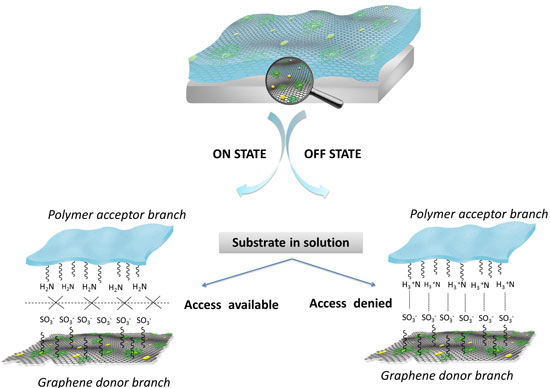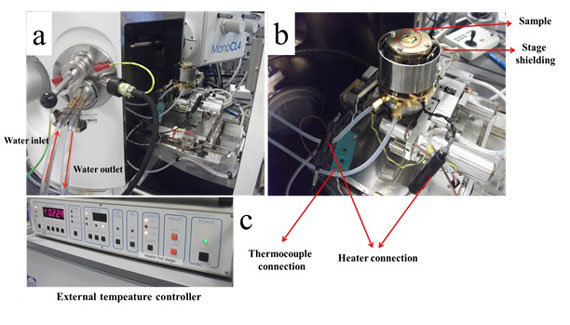| Posted: Oct 31, 2013 | |
Auto-switchable graphene bio-interface with a 'zipper' nanoarchitecture |
|
| (Nanowerk Spotlight) Today, material science is having a renewed influence on bioelectronics design beyond the incorporation of new functional nanomaterials. This newly established cooperation opens new windows for bioelectronics research, especially for fabricating flexible and smart devices. | |
| In this respect, as a newly developed form of carbon, graphene, has been widely explored in the field of bioelectronics owing to its unique physical and electrochemical properties. | |
| Recent advances in graphene research provide various possibilities to enhance performance characteristics and current approaches to design new bio-devices. Especially, smart and flexible bioelectronics on graphene has emerged as a new frontier in this area. | |
| Graphene has come to be seen an ideal signal transducer and promising alternative for the production of low cost bioelectronics devices. However, control and regulation on biological systems are always desired for advance applications and productions. | |
| The integration of biomolecules with electronic elements to fabricate functional devices attracts considerable attention because of the basic fundamental scientific questions and the potential applications of the system. This integration brings not only numerous variations and interdisciplinary research opportunities for academia, but also leads to the fabrication of many bio-devices such as biosensors, biofuel cells and bioreactors for commercial applications. | |
| In the October 20, 2013 online edition of Advanced Materials ("On/Off-Switchable Zipper-Like Bioelectronics on a Graphene Interface"), the Smart Materials and Biodevices group lead by Prof. Ashutosh Tiwari, Linköping University, Sweden reported for the first time the fabrication of an on/off switchable zipper-like graphene interface in order to control interaction between biomolecules and electrode materials. | |
 |
|
| Schematic representations of on/off switchable bioelectrocatalytic graphene interface. (Image: Prof. Ashutosh Tiwari, Linköping University) | |
| This invention is aimed at addressing the design and development of a novel auto-switchable graphene bio-interface that have positive response, by creating 'zipper' nanostructures. | |
| Using electrochemical techniques, they demonstrated that the interfacial bio-electrochemical properties can be tuned by modest changes in temperature. | |
| Such an ability to independently control and regulate the function of the interface has important outcomes for the design of novel bio-devices. | |
| The zipper consists of a two-dimensional graphene donor and a polymeric receptor, which are assembled together based in a stoichiometric interaction. At a relatively low temperature (i.e., 20°C), hydrogen bonding creates a coalescence of the graphene interface, thereby causing considerable shrinkage in the donor-to-acceptor interface. Thus access of an associated enzyme to its substrate is largely restricted, resulting in a decrease in the diffusion of reactants and the consequent activity of the system. | |
| In contrast, at a comparatively high temperature (i.e., 40°C) the donor-receptor interaction was subverted. As a result, the bio-substrate could freely access the enzyme facilitating bio-electrocatalysis. | |
| More importantly, this provides the first example of responsive bioelectronics being achieved on a two-dimensional graphene interface by controlling the external temperature as an on/off-switchable model. | |
| The structure change of the graphene based bionanocomposite on the electrode surface was investigated by in situ temperature-controlled scanning electron microscopy and in situ morphology change has been shown for the first time. | |
 |
|
| Set-up for temperature-controlled SEM experiments with lower (a) and higher (b) magnifications, and external temperature control device (c). (Image: Prof. Ashutosh Tiwari, Linköping University) | |
| The temperature of the surrounding was controlled by using additional electrical heating/water cooling equipment that is design by our group. At 20°C (a in figure above), the structure has contained any narrow channels and pores, while at 40°C (b), the surface displayed more compact and rough characteristics which allow the interaction of biomolecules with the electrode surface. | |
| The invention clearly demonstrates for the first time an on/off-switchable zipper-like graphene interface with a simple-to-use, inexpensive, and high-order system in a model bio-sensor, which is highly selective, sensitive, and stable. | |
| The electrochemical measurements have shown that the interfacial electrochemical properties can be tuned by varying the surrounding temperature. We believe that the fundamental design behind the present work is both attractive and novel. Ideally, it could make significant contributions to advanced bio-catalysis and material sciences, leading to self-switching bio-catalysis by utilizing reusable, cost-effective and simply-made nanomaterials. | |
| In nature, reactions are compartmentalized, and attempts to construct artificial systems have generally resulted in vastly inferior performance. This biotechnological problem could be solved by the use of zipper-like graphene interfaces to segregate reaction conditions at a molecular level. Conditions could then either be switched in a single compartment, by the use of graphene zipper, or the products of one reaction in a sequence passed to the second reaction in the biological chain by intelligent switching of the nanomaterial. | |
|
By Onur Parlak, Anthony P. F. Turner and Ashutosh Tiwari, Biosensors and Bioelectronics Centre, Linköping University, Sweden
|
|
|
Become a Spotlight guest author! Join our large and growing group of guest contributors. Have you just published a scientific paper or have other exciting developments to share with the nanotechnology community? Here is how to publish on nanowerk.com. |
|
